Define your design area that contains all regions which
are allowed to be morphed.
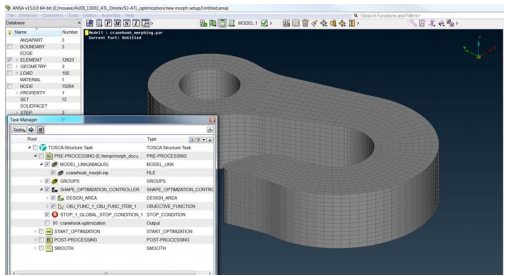
To add a new MORPHING folder to your optimization task, right click on Tosca Structure Task and select :
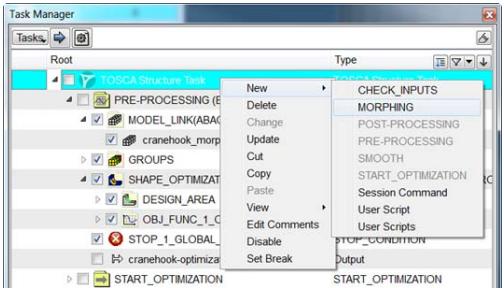
The MORPHING folder appears in Tosca Structure Task:

For each morphing area add a MORPH_AREA block via right-click on
MORPHING folder:
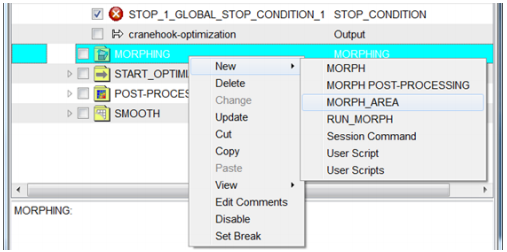
For each MORPH_AREA different properties can be defined. Define a
name for your MORPH_AREA, here MORPH_AREA_1, then select under ND_GROUP the GROUP_DEF option. In GROUP_DEF, enter a ? and select or define a
node_group describing the area to morph. Under TYPE, select the
direction of the morphing displacements vectors. So far only
NORMAL is supported Under TRANSITION_ZONE the number of nodes as
transition zone can be entered:

Create the set of necessary MORPH_AREA definitions. The definitions
can be highlighted interactively on the FE model:
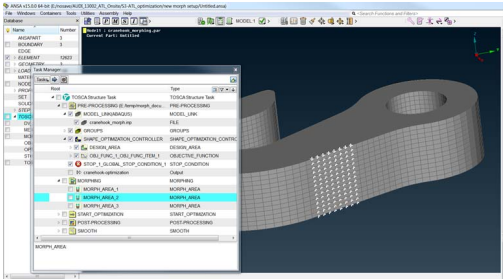
Add a new MORPH command via right-click on MORPHING folder and
adding :
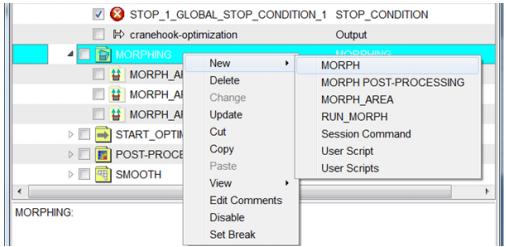
To link your MORPHING with a valid shape optimization task, do the following : - Define a name in the pop-up window.
- Click
in OPTIMIZE.
- Type ? and select your previously defined
shape optimization, here
OPTIMIZE_1_SHAPE_OPTIMIZATION_CONTROLLER

Note:
All
manufacturing and design variable constraints defined in this
optimization task are considered during the morphing.
Define an experiment plan. Save your morphing scheme in a *.csv
-file, e.g. cranehook_morph.csv (see, e.g. the User Manual), where
the first line refers to the morphing areas and each following line
corresponds to one model variant:
0, Morph1, Morph2, Morph3, Morph4, Moph5, Morph6, Morph7
1, 3.0, 0.0, 0.0, 0.0, 0.0, 0.0, 0.0
2, 0.0, 3.0, 0.0, 0.0, 0.0, 0.0, 0.0
3, 0.0, 0.0, 3.0, 0.0, 0.0, 0.0, 0.0
4, 0.0, 0.0, 0.0, 3.0, 0.0, 0.0, 0.0
5, 0.0, 0.0, 0.0, 0.0, 3.0, 0.0, 0.0
6, 0.0, 0.0, 0.0, 0.0, 0.0, 3.0, 0.0
7, 0.0, 0.0, 0.0, 0.0, 0.0, 0.0, 3.0
8, 3.0, 3.0, 3.0, 3.0, 3.0, 3.0, 3.0
9, 0.0,-2.0, 0.0, 3.0, 3.0, 0.0,-2.0
In this example, each morphing area will first be morphed with a displacement
of 3 mm. Then we will morph all the design areas simultaneously to see
the effect of a large-scale geometric change. In the last experiment, a new
geometry of the crane hook will be created. For this experiment, some MORPH_AREA
will shrink, and others will grow. This is controlled by a negative/
positive sign in the *.csv-File.
Select your MORPH_PARAM_FILE csv file to be executed. Then
select the morphing areas:

(optional) Define PARALLEL_JOBS and SMOOTHING:

With
PARALLEL_JOBS the number of parallel solver runs being started by
Tosca Structure can be defined. E.g. 2 means that Tosca Structure
runs always 2 FE
solver runs in parallel (as long as enough morphing variants are
available for calculation) SMOOTHING switches surface smoothing of
nodes in modified morphing areas on/off.
Run the morph task. Add a 'RUN_MORPH' command via right-click on
MORPHING folder.
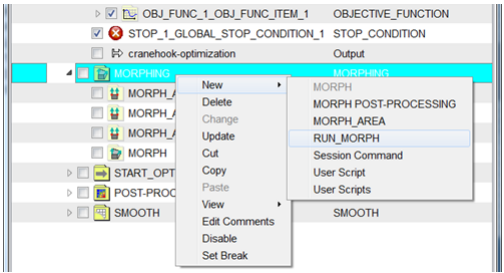
Create your visualization sequence using Tosca Structure.report in
the same way like for shape optimization results: select your
results using MORPHING | MORPH POST-PROCESSING |
GENERATE_MORPH_POST_FILE | CONTOURPLOT and visualize with MORPHING
| MORPH POST-PROCESSING | GENERATE_MORPH_ POST_FILE | MORPH_VTF_VISUALIZATION | VIEW:
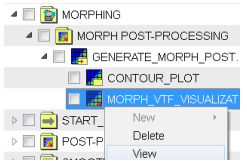
The result looks as follows:
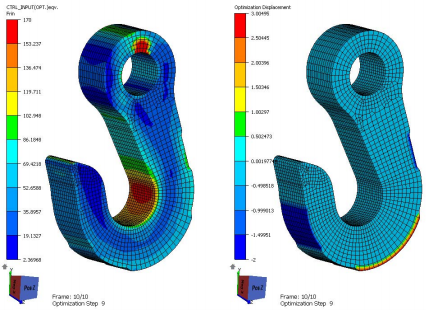
In the *.vtfx-File, you can see the controller input (f.e. stresses) and the nodal
displacements for all experiments. Each frame corresponds to an experiment.
In this example, the experiment 8 with the large-scale modification of the
geometry gives the best results for the stresses. The experiment 9 which is a
combination of grow and shrink gives good results too, and the modified
geometry is significantly lighter than the geometry in the experiment 8. So the
experiment 9 can be a good compromise for further processing (e.g. a subsequent
local shape optimization...).
|












